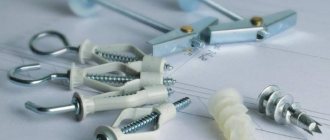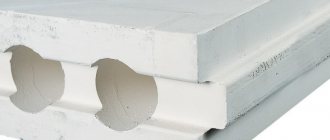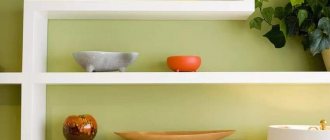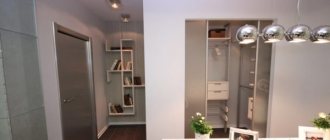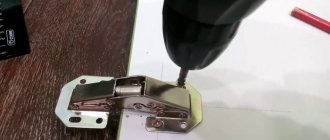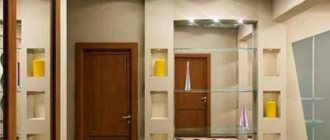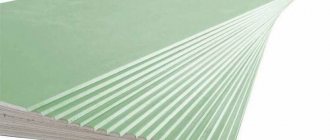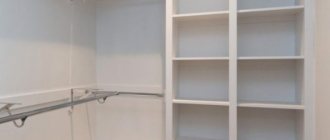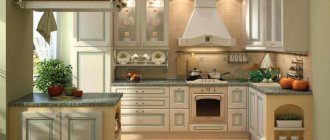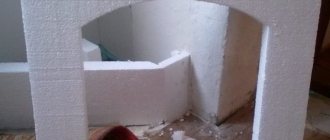What are butterfly dowels used for?
This device is intended for durable fastening of home interior elements to drywall. Drywall dowel Butterfly consists of two parts: expansion and static. The spacer part is inserted into a hole made in the plasterboard sheet and expands when the threaded fastener is screwed in, thereby making the connection strong. The dowel has a border that prevents it from falling into the drywall.
Many experts recommend using the Butterfly dowel to attach elements to drywall.
Dowel Molly
A dowel that works on the “butterfly” principle, but consists entirely of metal, is called a molly. The molly metal dowel for drywall is chosen by those who value the high quality of the product, despite its cost. Work with this fastener is carried out in the following sequence.
- Markings are made on the wall to secure the planned structure.
- Through holes are made in the designated places using an 8 mm drill. There are mollies with a diameter of 6, 5 and even 4 millimeters, but the most popular and frequently used are 8 mm. The length can vary between 21-80 mm.
- Molly is pressed into the hole all the way.
- The dowel is equipped with a special screw. This screw is screwed into the molly until it stops, opening the petals on the reverse side. After this, the screw is unscrewed, but the dowel will remain firmly fixed in the drywall.
- Now you can use the same screw to fasten the material to be fixed.
Using a special tool, the screw is pulled back so that the dowel petals open.
Professionals consider this technique to be a little incorrect. The fact is that when the molly is inserted into the hole, the screw is pulled back with the help of a special gun, and the petals open. Then the screw is unscrewed and the desired structure can be installed. However, not everyone will buy such a special tool to hang one shelf or mirror.
As you might guess, the principle of operation of metal and plastic dowels for gypsum plasterboard is not much different. However, a molly dowel for drywall is a fastener that is suitable for use even after dismantling. It can be easily unscrewed and installed in a new place, and the plastic butterflies are disposable.
The material used to make molly is galvanized or stainless steel, so there is no doubt about the durability of the product. Galvanization is carried out using the galvanization method and is considered to be fairly good protection against corrosion. Stainless steel is even more resistant, but its price is much higher.
Which molly screw should you choose:
hook. This screw head is in demand when mounting ceiling lights;- ring. A dowel for gypsum boards with a ring at the end of the screw is necessary for installing communications or fastening structures that are suspended (for example, a punching bag);
- secret head. This is a classic option in which the screw is easily buried in the attached material;
- L-shaped hook. This anchor for gypsum boards is used when installing wall lamps or some types of household appliances.
Types of products
There are several types of fasteners of this type that are used in different situations, the following butterflies for drywall are especially in demand:
Butterfly dowel 8x28
This element is used for fastening small, lightweight structures, and is the smallest. Good quality products are sold everywhere, and the price is no more than 50 kopecks. This element is not used as often as the next one.
Dowel Butterfly 10x50
The most popular fastening option, it is widely used by both private craftsmen and construction companies. The difference between this element and the first is that the spacer elements are much larger - this results in a better quality fastening. In addition, there is a double tongue inside the product, which increases the strength of the screw.
Important! Products can be made from several types of material - polypropylene, nylon, polyethylene. And when choosing, you need to base your choice on the elasticity of the material. Remember, if the dowel is rigid, it will break when screwing in the screw.
These hangers cost 1 ruble apiece, which is inexpensive if you consider that one fastener can withstand a load of 24 kg. If you use two dowels, you can hang cabinets or shelves on them.
Metal dowel Butterfly
This pendant is made of metal and is called “Molly”. It differs from plastic structures not only in material; this fastener has a large size range:
- self-tightening fasteners;
- L-shaped projection design;
- ring-shaped dowels;
- with a hook-shaped protrusion.
Thanks to this, these elements have a very wide range of applications. The metal structure is much stronger than plastic elements; it is similar to an anchor. But do not forget that the strength of drywall is much less than the strength of fasteners and profiles.
Universal dowel
Scheme for installing drywall using a butterfly dowel
If we consider the butterfly dowel-nail for drywall, then we should note the universal elements used for both solid products and sheet material.
Manufacturers produce different hangers and dowels depending on the material of manufacture and configuration, but they have one common element - a hole for a self-tapping screw and slots for expansion. The best option is a nylon anchor, as it is the most elastic.
If we consider the sizes, then there are a large number of them, the difference is in diameter and length, so choosing the option that suits you is not difficult. Universal elements are slightly lower in strength than special ones, so if you need to hang a kitchen cabinet on plasterboard, it is better to use a Butterfly dowel nail.
Butterfly dowel for drywall - 4 product options and features of use
All of the options I have discussed below can be used for certain jobs; I consider only proven solutions that have proven themselves well among buyers and specialists. It is possible that not all types of products are available in your city, but the most universal ones are usually presented everywhere. Different manufacturers produce different configurations of dowels, so it is not a fact that you will purchase the same option, it may differ in its design, the only common parts are a hole in the end for a self-tapping screw and two or more slots along the element.
Naturally, the material of manufacture must be elastic, the ideal solution is nylon dowels. This option differs primarily in the material of manufacture, its second name is “Molly”, which, by the way, is also what plastic Butterflies are called. Unlike plastic options, the size range of such elements is quite wide, and they can be made not only in the form of self-tightening fasteners, but also have a protrusion in the form of an L-shaped screw, ring or hook.
This significantly expands the scope of use. Products can be made from different materials: nylon, polypropylene, polyethylene, etc. When choosing, be sure to check the elasticity of the material; if it is too hard, then the dowels will break when fastening. If you are drilling the ceiling, then put Place a cup on the drill as shown in the photo; all debris will be collected in it and the room will remain clean.
What are the advantages of butterfly drywall fasteners?
This fastener has many advantages:
Steps for installing drywall using a butterfly dowel
- can be sold either complete with a self-tapping screw or separately, so you can easily replace the threaded element with a ring or suspension;
- the ribbed surface helps to firmly fix the element in the gypsum board sheet;
- the legs, which diverge when the screw is screwed in, distribute the load on the drywall, thereby ensuring the rigidity of the structure;
- The versatility of this fastener allows it to be used even for walls made of chipboard.
The butterfly dowel nail in the plastic version with 12 mm thickness can withstand several uses. This nuance makes the fastener very popular among ordinary people.
Butterfly
Butterfly dowel fasteners are considered the best option for fastening light-weight structures, decorative elements to drywall, and various plywood panels.
Its name appeared due to its specific appearance, since the fastener has a shape similar to this insect. It is created on the basis of polypropylene; in order to mount it, you will need to prepare a hole with the required diameter for its body.
This fastener will help if necessary:
- Hang a lamp or other lighting fixture;
- Create support for wiring various cables;
- Fix any switch;
- Strengthen various types of skirting boards;
- Install a not particularly massive cornice.
Important: The thickness of the material should not exceed 10-12 mm.
What are its advantages:
- It is easier to screw in the screw for fastening;
- You can remove it if necessary.
Rules for securing a butterfly dowel
Using the anchor is very simple, just follow the instructions for the work:
- The first step is to determine the installation location of the structure; do not forget that the kit may not include self-tapping screws and they will have to be purchased separately.
- Using a building level, the installation of fasteners is marked - the main thing is not to make a mistake, otherwise the wall will be damaged.
- You need to drill drywall with a drill whose diameter is 8 mm. Don't forget that drywall is a very malleable material, so you can use a wood drill to work with it. It is better to use a screwdriver for drilling; its power is enough for this material, especially since it is much more convenient to work with it.
Attention! When drilling a structure on a plasterboard ceiling, put a plastic cup on the drill, which will collect debris and keep the room clean.
- The dowel must be grasped with your fingers and threaded through the hole made earlier, up to the head of the product. Now you can screw in the screw. After such installation, a structure is obtained that can withstand a weight of 17 kilograms.
- The fixing element is attached last, the size of which will be selected based on the thickness of the screw, for example, if the dowel is three millimeters, then a screw-in element of 3.5 mm is taken.
Option for installing drywall using a butterfly dowel
- The screw must be screwed in all the way, only in this way the elements of the dowel will expand as much as possible and be securely fixed to the plasterboard wall. The work is simple and takes a minute, especially if a screwdriver is used for screwing.
The video shows how to properly attach a butterfly dowel to drywall.
I would like to note that for attaching household items to plasterboard walls, it is worth using the Butterfly dowel nail - it is an easy-to-use and reliable fastener. Choosing the right fastener is quite simple, since the range of this material from different manufacturers and from various materials on the market is large. Even professionals appreciated the practicality of using this type of fastener on plasterboard structures.
Dowel-nails
Also used when hanging light objects on plasterboard surfaces. This fastener is popular because of its convenience and low price. It is usually made of plastic, but there are also aluminum varieties.
Installation is simple:
- A hole is drilled corresponding to the thickness of the hardware.
- The plastic part is carefully driven in with a hammer.
- The screw rod is also driven in with a hammer. It has Phillips slots in case you need to remove the screw. But it is almost impossible to get the plastic part out of the gypsum board.
USEFUL INFORMATION: Modular sockets on DIN rail
For all their convenience, these hardware are used for fastening only light objects to a plasterboard surface.
Drywall dowels, basic types and selection rules
To attach a picture, shelf to a partition made of plasterboard sheet (GCR), or to hang a lamp on a plasterboard sheet, you need to have an idea of the existing types of fasteners used in such a situation. The article provides a brief overview of the main mounting accessories. Dowels intended for brick walls do not adhere to products made of plasterboard, asbestos, fiberboard, particleboard, and MDF boards. Firstly, due to the small contact area, and secondly, due to the insufficient strength of the material, and a plasterboard dowel works on a different principle. Instead of expansion inside the hole, the carrier sheet is crimped on both sides, although some types of fasteners (DRIVA, for example) also work with expansion.
Molly
We consider the dowel with the name Molly last, since it is capable of withstanding the highest level of payload in comparison with other popular types. In shape, it can easily be confused with the expansion version of the anchor bolt, used on concrete or brick.
Its design consists of a sleeve with longitudinal slots and a nut at one end, as well as a flat-type head with teeth at the other to secure the sleeve during tightening of joints. A screw is inserted through the inside of the dowel, which is necessary for proper use on the base of the nut during installation work.
What are its advantages: It has a high level of permissible load.
We also note significant disadvantages:
- Cannot be used in too close spaces;
- Such fastenings cannot be removed without causing damage to the partition.
You can buy any of the types of fasteners discussed on the market or in a store, however, it is worth considering the sizes of drywall dowels based on the diameter of the head and the length of the leg. In addition, it is recommended to take into account the type of wall surface and the level of load on the dowel.
To do this, you can rely on metal versions, which have an increased price, or plastic, nylon models that have recently appeared on the market. They are cheaper and never rust, but are less resistant to increased loads.
Now you have a lot of information about the different dowels suitable for drywall. But to make the choice even easier, you can ask the store for a catalog of the best dowels from world-famous brands. But this may be necessary if you plan to purchase really good fasteners for long-term use and price is not a priority.
Drywall fasteners
Repair has become an integral part of the life of a modern person. To make your home not only beautiful, but also durable, you must use only reliable and high-quality materials. It is also worth considering the type of fasteners - the service life of the structures being built depends on it. Self-tapping screws for drywall are an excellent option for fastening elements.
There are many types and sizes of them, so it’s worth understanding them before going to the hardware store. Special self-tapping screws for drywall allow you to work with the popular material as conveniently and quickly as possible.
Butterflies for drywall
Nowadays, plasterboard sheathing is becoming increasingly popular. To install them, a frame made up of metal profiles connected by various types of fasteners is attached. One of the best fastening options for such a structure is a butterfly dowel for drywall. Butterflies for drywall are used somewhat more often than similar fasteners, which is not strange, because the butterfly for drywall has obvious advantages that bring it to the fore. Some characteristics of such fasteners as the butterfly dowel differ from other types of fastening.
For example, the butterfly is great for fastening both one sheet of plasterboard and two-layer sheathing. You can find commercially available screws with self-tapping screws that match their size and type of thread. However, the butterfly can often be used with other screws.
The dowel part, located inside the plasterboard sheet, has ribbed elements that do not allow the butterfly to rotate. This diagram will allow you to more clearly understand how the butterfly dowel works and how it is designed. It contains useful information about this tool.
It is recommended that you familiarize yourself with the parameters provided in order to better understand the operating principle of the fastening tool and its performance. Correct installation is very important, since the reliability of the fastening depends on it. Let's figure out how to properly fasten the butterfly dowel so that the fastening will serve you for a long time and serve you well.
Butterfly for drywall is the most popular among all other variations of dowels for working with plasterboard. GKL fastening with the help of such an unusual dowel can be carried out not only by highly qualified professionals, but also by amateurs. Other species are not so popular, although competition does occur.
Self-tapping screws for wood and metal
Fasteners for drywall are selected depending on the method of installation of the material. For example, if metal profiles are used, choose metal screws. This will ensure maximum strength of the panels being installed. To attach sheets to wooden sheathing, buy drywall screws for wood.
The purpose of the fastener can be determined by its appearance. The main differences are the type of thread. For example, for wood the thread pitch is sparser than for metal. To attach drywall to a reinforced profile, you will need to choose the type of screws with a drill. This will help get rid of pre-drilling the sheet and will significantly save time when installing drywall, even if you take into account that there will be a fairly short distance between the fasteners. Self-tapping screws for plasterboard for metal have a higher thread frequency.
Each self-tapping screw that is used for drywall, regardless of type, has a number of distinctive features:
- Made in black. This sign is evidence of reliable protection of the self-tapping screw from corrosion - the fastening element has a phosphorized or oxidized coating.
- A carving that is made like a pointed spiral. This design allows the screws to quickly screw into any surface.
- Horn type head. When screwing in the self-tapping screw, it is completely recessed. This allows subsequent finishing to be carried out without problems.
- The PH-2 cross-head slot ensures easy screwing in of self-tapping screws both manually and when using a screwdriver. The presence of cross-shaped attachments for the slot allows you to choose between fasteners of different price categories.
In addition to determining the quality of the screws, it is worth paying attention to the dimensions of the fasteners.
Types of drywall dowels: butterfly (video)
The choice of fasteners is not the least important thing during repairs. Always purchase fasteners from trusted sources and from trusted manufacturers. You can calculate the required amount of fasteners using an online calculator; these services are easy to find on the Internet.
Happy renovation!
- Author: admin
Rate this article:
- 5
- 4
- 3
- 2
- 1
(0 votes, average: 0 out of 5)
Share with your friends!
Sizing
Drywall fasteners include many products of varying lengths. This is due to the variety of goals pursued. For example, if you need to secure two sheets at once, you will need a longer self-tapping screw. The choice also depends on the type of wood into which the fasteners will be screwed. For these reasons, there are self-tapping screws of different lengths for different tasks.
The dimensions of the fastener are usually determined “by eye”. However, there is another way - look at the product labeling. For example, if it says 4.5x80, it means that the self-tapping screw has a diameter of 4.5 mm and a length of 80 mm. It is worth remembering that fasteners must be recessed into the plasterboard by 1 mm.
Dowel selection
The selection of fasteners for drywall requires taking into account many factors:
- planned load;
- possibility of dismantling;
- product price.
The process of selecting a dowel is quite individual, since each specific situation may require completely different fasteners.
But still, the most reliable option would be to mount it into load-bearing profiles, since in this case, the area on which the load is created is almost hundreds of times higher.
Signs of high-quality fasteners
Every experienced worker knows that when a defective batch arrives, the consumption of self-tapping screws increases significantly. Most often this happens due to oversight. However, you can pay attention to the following nuances in choosing self-tapping screws:
- Appearance. All elements must be the same size. If the screws have various defects (damage, bending), they should be considered defective. The strength characteristics of such fasteners leave much to be desired.
- The hole for the slot on the screws is clearly visible and is located directly in the center of the cap. If there are visible bulges, dents or sagging on it, you should choose another batch. If you use low-quality fasteners, you can not only screw in the screw incorrectly, but also damage the screwdriver attachment.
- Each self-tapping screw must be black - this is a sign of a special coating that prevents metal corrosion.
Important! Every major manufacturer that produces only high-quality products applies markings to their products.
Drywall can be fastened with various dowels. They are divided into the following categories:
- dowel nail;
- "Umbrella";
- "Molly"
- "Butterfly";
- Driva.
First you should pay attention to the dowel-nail. It is used for fastening to a plasterboard sheet that is glued to the wall. When using a dowel-nail, it is important that there is a contact patch where it is driven in. This means that there should be no air gap. This method of fastening does not pose any difficulties.
Things are more complicated with drywall attached to profiles. It is usually difficult to predict where a profile is installed. In this case, you should pay attention to fasteners specially designed for such cases.
"Molly"
Such drywall dowels are the most common fasteners. They belong to expanding products. During screwing, such a dowel clamps the drywall panel between its two parts - front and back. “Molly” is quite expensive, but this choice is justified if installation reliability must be high. The main advantage of Molly is its ability to withstand up to 35 kg of load. Also, if necessary, such dowels can be easily dismantled.
How to fasten drywall with such a dowel? There are no difficulties in the process of twisting Molly. First you need to make a hole with a diameter of 8 mm. After this, a dowel is placed in it and the side is pressed down using teeth to prevent possible twisting. Then you need to screw in a screw that will press the back of the dowel into the drywall panel. This indicates successful completion of the installation. Self-tapping screws are not needed. Such dowels are used for plasterboard sheets ranging in size from 1.2x2 to 1.2x3.6 m.
"Umbrella"
The “umbrella” dowel is named after its operating principle. Its design includes two plates that are released by a spring. Fastening with such a dowel is quite simple. The work will not be difficult even for a beginner. For the dowel, you need to pre-drill a hole.
After this, an umbrella is inserted into it. The plates at this moment are in a compressed state. As soon as they reach free space, the spring begins to push them apart. Thanks to this, the dowel is securely fixed in the wall or ceiling. Using this fastener you can hang a chandelier. However, a ceiling made of plasterboard will not be able to support a punching bag.
Important! Such dowels cannot be dismantled. For this reason, it is worth paying special attention to marking and determining the mounting location.
"Butterfly"
Common fasteners include the “Butterfly” dowel for drywall, which does an excellent job of securely fastening the popular material. It looks a bit like the Molly dowel. The main difference is that such elements are made of plastic. Also, fixing drywall is carried out with a smaller mounting area. The permissible load on such a dowel is also significantly lower than on “Molly”
The only difference is the installation principle. First you need to drill a hole, then insert the dowel not all the way and, while holding the product with pliers, screw in the self-tapping screw until the petals open. When this happens, the dowel is driven all the way, and then the self-tapping screw is tightened. The fixation is quite reliable.
Plasterboard dowel butterfly fastener and its device
A butterfly dowel is a self-tapping fastener that is clamped when twisted, which is achieved due to its unique design.
- Special legs fit tightly to the back surface of the drywall, which allows you to significantly increase the area that can absorb the load coming from the mass of the suspended object.
- That is, such fasteners help to uniformly distribute the entire load applied to the drywall sheet.
- Such a dowel is characterized by the following design features and characteristics:
- Used for fixing a single or double layer of drywall (thickness 10-12 and 20-24 mm, respectively);
- The package includes self-tapping screws suitable for the type of thread and length, although its use is possible with other screws, provided that they correspond to the required standard sizes;
- The part of the butterfly dowel located inside the sheet of drywall has a number of ribbed elements that prevent the anchor from rotating around its axis;
- The presence of an internal thread on the head ensures the dowel is clamped and folded, and the internal legs guarantee increased rigidity of the element in the twisted position.
Varieties of butterflies for drywall
Depending on the conditions of use and the type of material being fixed, butterfly dowels for drywall can be made of:
Metal dowels are characterized by improved practicality and reliability, but also have an increased cost. They are able to withstand heavy loads, and to increase their service life, many manufacturers treat them with special anti-corrosion compounds. The metal butterfly dowel is most popular among professional drywall makers. It’s more convenient to work with; you can’t twist it or tear it like plastic, and especially nylon. But the price of such dowels can significantly increase the estimate, especially for large-scale work with gypsum boards.
Nylon and plastic dowels are modern variations, distinguished by their lightness, availability and immunity to rust, but having reduced mechanical stability and a reduced threshold for permissible loads. These butterflies for gypsum boards are much cheaper and provide significant savings.
Current prices for butterfly dowels made of various materials per pack of 4 pieces:
- Butterfly dowel, plastic size 10x50 with screw: 32 rub.
- Butterfly dowel polypropylene size 10x50 with screw: 26 RUR.
- The metal butterfly dowel already has different dimensions due to the design features. For example, the price for a metal butterfly dowel with a 4x24 screw: 74 rubles.
If you compare prices, you can immediately see that metal butterfly dowels are more than twice as expensive as plastic ones, and especially polypropylene ones!
Attaching to an unstable surface
Modern houses have many surfaces made of not very durable materials. These include drywall, old brick, wooden boards or slabs of pressed sawdust. When working with them, it is better to use nylon fasteners with a diameter of more than 10 mm; the installation depth should not be less than 6 cm. It is better to choose a gimlet that is several sizes smaller.
The drilling process should be shock-free, as excessive load can damage the surface. Using the impact mode may not leave visible damage, but the internal structure of the wall may be damaged. If the diameter of the drill is too large, the fasteners will move freely in the hole, gradually increasing its diameter, especially if the work was carried out with aerated concrete.
For plasterboard walls, it is not necessary to use a drill of a smaller diameter, the main thing is not to put pressure on the drill and not to use the impact mode. Drywall is a very delicate material, even a small load can lead to the destruction of a section of the wall. Drill the hole with light force so that it matches the size of the plastic dowel with self-tapping screw.
It is worth understanding that there is no need to attach heavy structures to such surfaces, even if the material initially copes with the load, over time, collapse may occur under heavy weight.
If you take into account the material from which the wall is made, choose the right dowel and drill for it, and also have a high-quality tool on hand, you can make a high-quality installation and not worry about the safety of your furniture or household appliances. By following the recommendations, even an inexperienced craftsman can handle such installation.
